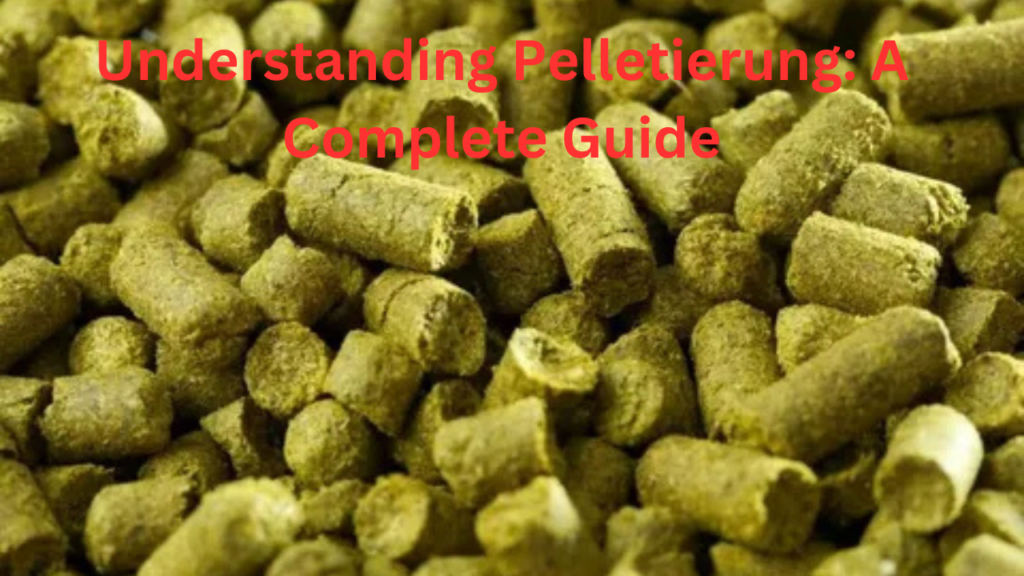Pelletierung, also known as pelletizing, might not be a term everyone knows, but it plays a crucial role in industries like biomass energy production and pharmaceuticals. If you’re curious about how biomass pellets are made or how pelletization impacts your daily life, you’re in the right place!
Let’s break down everything you need to know in simple terms, from the basics to the latest trends.
What Is Pelletierung?
Pelletierung is the process of turning raw materials, like biomass, into small cylindrical pellets. These pellets can be made from materials such as wood, grass, or agricultural waste. Why go through all this trouble? The answer is simple: to create compact, easily transportable fuel or raw material for various industries.
When it comes to biomass, pelletization is especially valuable because it creates an efficient energy source. So, whether you’re heating your home or looking for an alternative to fossil fuels, pelletized biomass is a green and efficient option.
The Pelletization Process: Step-by-Step
Now that we know what pelletizing is, let’s take a closer look at how it actually works. The process involves several key steps to ensure that the pellets are just right for their intended use.
Step 1: Raw Material Preparation
Before anything can be compressed into pellets, the raw material needs to be prepared. This usually involves drying the biomass to reduce its moisture content. If the material has too much moisture, it will be harder to compress, and the pellets might not form properly.
Step 2: Grinding
Once the material is dry, it’s time to grind it into a fine powder. Think of this step like turning a big chunk of something into dust. This step is essential because it allows the material to be easily pressed into pellets later on.
Step 3: Conditioning
Next up is conditioning. In this stage, we add a little moisture back into the material and sometimes a binder. The moisture helps with the compression process, while the binder ensures the pellets hold together during production and later use.
Step 4: Pelleting
Now, the fun part: pressing the material into pellets! The conditioned mixture is fed into a pellet press, where high pressure compresses the material into small, cylindrical shapes. The pressure is so intense that the heat generated helps the pellets form a solid, compact structure.
Step 5: Cooling
Once the pellets are pressed, they need to cool down. If they don’t cool properly, they might expand or lose their shape. So, after pressing, the pellets are transferred to a cooling system that helps them maintain their compact form.
Step 6: Screening
Finally, after cooling, the pellets are screened for size and quality. The goal here is to make sure every pellet is uniform in size and free from any defects. If any pellets don’t meet the standard, they are removed and can be recycled back into the process.
Applications of Pelletierung
Pelletierung isn’t just about making fuel. The pellets produced through this process have many different applications across industries. Let’s take a look at some of the most common ones.
Energy Production
Biomass pellets are primarily used for energy production. They’re a renewable energy source and can be burned in heating systems or power plants to generate heat or electricity. Unlike burning raw biomass, pellets have a higher energy density, making them more efficient to transport and use.
Pharmaceuticals
In the pharmaceutical industry, pelletization is used to produce uniform dosages of medication. This allows for precise control over how and when the medicine is released into the body. For example, pellets can be designed to dissolve slowly, providing a controlled release of the active ingredient over time.
Animal Feed
Another application is in animal feed production. Just like in pharmaceuticals, pelletizing helps ensure that the nutrients in animal feed are evenly distributed, so each pellet provides consistent nutrition. This is especially important in commercial animal farming, where feed quality directly impacts the health and growth of livestock.
Advantages of Pelletierung
So why go through the trouble of pelletizing materials in the first place? Here are some of the key benefits of the process:
Efficiency in Transport and Storage
Pellets are far more compact than raw biomass, which makes them easier to store and transport. Instead of dealing with bulky and often messy biomass, pellets take up less space and are easier to handle. This makes them much more cost-effective in the long run.
Environmental Impact and Sustainability
Pelletization plays a huge role in reducing environmental impact. Biomass pellets are a renewable energy source, meaning they don’t contribute to the depletion of fossil fuels. Plus, burning biomass for energy results in lower greenhouse gas emissions compared to burning coal or natural gas. So, by using pellets, we’re doing our part to reduce our carbon footprint.
Controlled Release in Pharmaceuticals
In the pharmaceutical industry, pelletizing is a game-changer. It allows for precise control over drug release, which can improve how medications work. Instead of dumping all the medication into the system at once, pellets can be designed to release it gradually, leading to better patient outcomes and fewer side effects.
Future Trends in Pelletierung
As we move into the future, pelletization is likely to evolve even further. Here are some trends to keep an eye on:
Impact of CO2 Pricing on Biomass Energy
One significant shift happening is the rising cost of carbon emissions. With stricter environmental regulations, the cost of CO2 emissions from fossil fuels is going up. This makes biomass pellets an even more attractive option. As governments increase CO2 pricing, companies may look to invest more in pellet-based energy systems to reduce their carbon footprint.
Innovations in Pellet Production Technologies
The pelletizing process itself is also being refined. New technologies are emerging that make the production process more efficient, cheaper, and environmentally friendly. For example, advanced pellet mills are now able to handle a wider range of raw materials, which could make pelletizing even more versatile.
Conclusion: Why Pelletierung Matters
Pelletierung might seem like a small piece of the puzzle in energy and pharmaceutical industries, but it has a massive impact. Whether it’s reducing carbon emissions, improving drug delivery, or making energy production more efficient, pelletization is making a difference.
You May Also Read: Calandrando: Embrace the Magic of the Unexpected
Frequently Asked Questions (FAQs) About Pelletierung:
1. What is pelletierung, and why is it important?
Answer: Pelletierung, or pelletizing, is the process of compressing raw materials, typically biomass, into small cylindrical pellets. It is important because it creates a compact, efficient form of fuel that is easier to transport and store. Additionally, pelletization is crucial in pharmaceuticals for producing uniform medication dosages.
2. What materials can be pelletized?
Answer: While pelletization is predominantly used for biomass materials such as wood, agricultural residues, and other organic matter, it can also be applied to various substances in the pharmaceutical industry, including powdered drugs and excipients used in medication formulations.
3. How does the pelletization process work?
Answer: The pelletization process involves several steps:
- Raw material preparation (drying),
- Grinding the material into a fine powder,
- Conditioning (adding moisture and binders),
- Pelleting (compressing the material into pellets),
- Cooling the pellets,
- Screening for size and quality uniformity.
4. What are the environmental benefits of using biomass pellets?
Answer: Biomass pellets are considered a renewable energy source that can significantly reduce greenhouse gas emissions compared to fossil fuels. Their use promotes sustainability by utilizing waste materials and reducing reliance on non-renewable energy sources.
5. What trends are shaping the future of pelletierung?
Answer: As we move forward, trends such as increased CO2 pricing may affect the cost-effectiveness of biomass energy solutions. This could drive innovation in pellet production technologies, improve sustainability practices, and enhance the overall efficiency of biomass energy systems in response to stricter environmental regulations.



